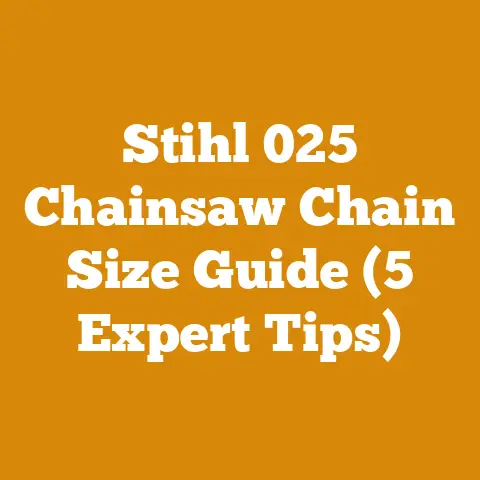Husqvarna 3120xp Specs (5 Expert Tips for Wood Processing)
As someone who’s spent countless hours in the field, I know that even the toughest chainsaws face wear and tear. Today, I’m diving deep into the Husqvarna 3120XP, a true beast in the world of wood processing. I’ll share specs, sure, but more importantly, I’ll give you five expert tips gleaned from years of experience to help you maximize its potential and extend its life.
Husqvarna 3120XP: A Deep Dive into Specs and Pro Tips
The Husqvarna 3120XP isn’t just a chainsaw; it’s a statement. It’s the “big gun” you reach for when you’re tackling massive trees, milling timber, or simply need raw power. But power alone isn’t enough. Knowing the machine inside and out, understanding its limitations, and mastering the right techniques are key to unlocking its full potential.
Unpacking the Specs: What Makes the 3120XP Tick?
Before we get to the tips, let’s lay the groundwork. Here’s a detailed breakdown of the Husqvarna 3120XP’s key specifications:
- Engine Displacement: 118.8 cc (7.25 cu. in.) This is the heart of the beast, dictating its immense power.
- Power Output: 6.2 kW (8.4 hp) A significant figure, translating to serious cutting force.
- Maximum Power Speed: 9,000 rpm This is where the engine delivers its peak performance.
- Idling Speed: 2,500 rpm The engine’s stable resting speed.
- Spark Plug: Champion RCJ7Y, NGK BPMR7A These are readily available and essential for proper ignition.
- Electrode Gap: 0.5 mm (0.02″) Maintaining this gap ensures a strong spark.
- Torque, Max: 6.5 Nm at 6,000 rpm Torque is what allows the saw to pull through tough wood.
- Oil Tank Volume: 1.2 liters (1.27 US quarts) Large capacity minimizes downtime for refills.
- Fuel Tank Volume: 1.2 liters (1.27 US quarts) Again, maximizing run time between fuel stops.
- Oil Pump Type: Automatic This ensures constant lubrication to the bar and chain.
- Oil Pump Capacity: 4-20 ml/min Adjustable to suit different cutting conditions.
- Recommended Bar Length: 50-100 cm (20-40″) The saw can handle a wide range, but balance is key. I prefer a 36″ bar for most heavy-duty tasks.
- Chain Pitch: 3/8″ or .404″ This refers to the spacing between the chain’s drive links.
- Chain Gauge: 0.063″ (1.6 mm) The thickness of the drive links.
- Weight (without cutting equipment): 10.4 kg (22.9 lbs) This is a heavy saw, so physical strength is important.
- Sound Power Level (LWA): 119 dB(A) Protect your hearing! Always wear ear protection.
- Sound Pressure Level (at operator’s ear): 103 dB(A) Another reminder to prioritize hearing protection.
- Vibration Level (front/rear handle): 6.7/9.0 m/s² Vibration can lead to fatigue and long-term health issues.
- Carburetor: Walbro WJ-69 or Tillotson HS-254 These are high-performance carburetors designed for demanding use.
- Ignition System: SEM AM51 This system provides reliable starting and consistent spark.
- Air Filter: Heavy-duty, two-stage This is critical for protecting the engine in dusty environments.
Takeaway: Knowing these specs allows you to understand the saw’s capabilities and limitations. It also helps with troubleshooting and maintenance.
Expert Tip #1: Mastering the Art of Chain Selection and Sharpening
The chain is the business end of any chainsaw, and with the 3120XP, it’s even more critical. A dull chain not only slows you down but also puts unnecessary strain on the engine and increases the risk of kickback.
Chain Selection:
- For general felling and bucking: A standard full chisel chain with a 3/8″ pitch is a good all-around choice.
- For hardwood: A semi-chisel chain will hold its edge longer, although it cuts slightly slower. I’ve found this particularly useful when processing oak or hickory.
- For milling: Use a ripping chain with a specialized grind angle for smooth, consistent cuts along the grain.
- Chain Pitch and Gauge: Ensure the chain pitch and gauge match your bar sprocket and drive sprocket. Using the wrong size will damage your saw. The 3120XP typically uses a .404″ or 3/8″ pitch.
- Number of Drive Links: This is crucial for proper chain length. Count the number of drive links on your old chain before replacing it.
Sharpening Techniques:
- File Size: Use a 7/32″ round file for 3/8″ pitch chains and a 13/64″ file for .404″ pitch chains.
- Filing Angle: Maintain the correct filing angle (typically 30-35 degrees) to ensure optimal cutting performance. Use a filing guide to help maintain consistency.
- Depth Gauge: Check and adjust the depth gauges (rakers) regularly. If they are too high, the chain won’t bite properly. If they are too low, the chain will be overly aggressive and prone to kickback. Use a depth gauge tool and a flat file to adjust them.
- Consistency: Sharpen each tooth evenly to maintain balance and prevent the chain from pulling to one side.
- Frequency: Sharpen the chain every time you refuel, or more often if you notice a decrease in cutting performance. A sharp chain is a safe chain.
Personal Story: I once spent an entire day struggling to fell a large oak tree with a dull chain. I was exhausted, frustrated, and making slow progress. Finally, I took the time to properly sharpen the chain, and the difference was night and day. The saw sliced through the wood effortlessly, and I finished the job in a fraction of the time. That day, I learned the true value of a sharp chain.
Data and Insights:
- A sharp chain can increase cutting speed by 20-30%.
- A dull chain can increase fuel consumption by 10-15%.
- Proper chain maintenance can extend the life of the chain by 50%.
Takeaway: Chain selection and sharpening are fundamental to maximizing the 3120XP’s performance and ensuring safe operation. Invest in good quality files and sharpening tools, and learn the proper techniques.
Expert Tip #2: Fuel and Oil: Feeding the Beast Correctly
The Husqvarna 3120XP is a high-performance machine that demands high-quality fuel and oil. Skimping on these essentials can lead to engine damage and reduced performance.
Fuel:
- Octane Rating: Use a minimum of 89 octane unleaded gasoline. Higher octane fuels may provide slightly better performance, but they are not strictly necessary.
- Ethanol Content: Avoid fuels with high ethanol content (E15 or higher). Ethanol can damage the fuel system and cause starting problems. E10 (10% ethanol) is generally acceptable, but it’s best to use ethanol-free fuel if possible.
- Fuel Stabilizer: Add a fuel stabilizer to the fuel if you are not going to use the saw for an extended period of time (more than a month). This will prevent the fuel from breaking down and gumming up the carburetor.
- Mixing Ratio: Use a 50:1 fuel-to-oil ratio. This means mixing 50 parts gasoline with 1 part two-stroke oil. Use a high-quality two-stroke oil specifically designed for air-cooled engines. I always use Husqvarna’s own oil, but Stihl or Echo oils are also good choices.
- Fresh Fuel: Always use fresh fuel. Gasoline can degrade over time, especially if it is stored in a non-airtight container. Discard any fuel that is more than a few months old.
Oil:
- Bar and Chain Oil: Use a high-quality bar and chain oil specifically designed for chainsaws. This oil is formulated to provide excellent lubrication and prevent premature wear of the bar and chain.
- Viscosity: Choose a bar and chain oil with the appropriate viscosity for the ambient temperature. In cold weather, use a thinner oil to ensure proper flow. In hot weather, use a thicker oil to prevent the oil from thinning out and losing its lubricating properties.
- Biodegradable Oil: Consider using a biodegradable bar and chain oil to reduce your environmental impact.
- Oil Level: Check the oil level frequently and top it off as needed. Running the saw with a low oil level can cause serious damage to the bar and chain.
Personal Story: I once made the mistake of using old, stale fuel in my 3120XP. The saw ran poorly, was difficult to start, and eventually stalled out completely. I had to clean the carburetor and replace the fuel lines, which was a time-consuming and frustrating experience. Since then, I’ve always been meticulous about using fresh, high-quality fuel.
Data and Insights:
- Using the correct fuel-to-oil ratio is crucial for engine longevity.
- High-quality bar and chain oil can extend the life of the bar and chain by 20-30%.
- Ethanol can damage the fuel system components, leading to costly repairs.
Takeaway: Using the right fuel and oil is essential for keeping your Husqvarna 3120XP running smoothly and reliably. Invest in quality products and follow the manufacturer’s recommendations.
Expert Tip #3: Mastering the Art of Felling and Bucking Techniques
The Husqvarna 3120XP is a powerful tool, but it’s only as effective as the person wielding it. Mastering proper felling and bucking techniques is crucial for safety, efficiency, and minimizing waste.
Felling Techniques:
- Planning: Before you start cutting, assess the tree for lean, wind direction, and any potential hazards (e.g., dead branches, power lines). Plan your escape route.
- Personal Protective Equipment (PPE): Always wear a helmet, eye protection, hearing protection, gloves, chainsaw chaps, and steel-toed boots.
- The Notch: Cut a notch on the side of the tree in the direction you want it to fall. The notch should be about 1/3 of the tree’s diameter. The angle of the notch should be about 45 degrees.
- The Back Cut: Make the back cut on the opposite side of the tree from the notch. The back cut should be slightly higher than the bottom of the notch. Leave a hinge of uncut wood between the notch and the back cut. The hinge will help control the direction of the fall.
- The Push: As the tree starts to fall, shout a warning and move quickly to your planned escape route. If necessary, use a felling lever or wedges to help push the tree over.
- Stump Awareness: After the tree is felled, examine the stump. A properly made cut will reveal valuable information about the tree’s internal health.
Bucking Techniques:
- Support: Always support the log before cutting it. This will prevent the log from pinching the saw and causing kickback. Use logs, branches, or wedges to support the log.
- Tension and Compression: Understand the forces of tension and compression in the log. If the top of the log is in tension, cut from the bottom up. If the bottom of the log is in tension, cut from the top down. This will prevent the log from splitting or pinching the saw.
- Step-Over Cut: Use a step-over cut to prevent the log from rolling. Make a partial cut on one side of the log, then step over the log and make a second cut on the opposite side.
- Boring Cut: Use a boring cut to remove a section of the log without cutting all the way through. This can be useful for removing knots or other defects.
- Limbing: When limbing, always stand on the uphill side of the tree and cut away from your body. Be careful of spring poles (limbs that are under tension).
Personal Story: Early in my career, I underestimated the importance of planning a felling operation. I felled a large pine tree without properly assessing the lean, and it fell in the wrong direction, narrowly missing my truck. It was a valuable lesson in the importance of careful planning and risk assessment.
Data and Insights:
- Proper felling techniques can reduce the risk of accidents by 50%.
- Understanding tension and compression can prevent the saw from pinching and reduce the risk of kickback.
- Using proper support techniques can improve cutting efficiency by 15-20%.
Takeaway: Mastering felling and bucking techniques is essential for safe and efficient wood processing. Take the time to learn the proper techniques and always prioritize safety.
Expert Tip #4: Taming the Vibration: Minimizing Fatigue and Protecting Your Health
The Husqvarna 3120XP, while powerful, is also a heavy and vibrating machine. Prolonged use can lead to fatigue, hand-arm vibration syndrome (HAVS), and other health problems. Minimizing vibration is crucial for protecting your long-term health.
Techniques for Vibration Reduction:
- Anti-Vibration System: The 3120XP has an anti-vibration system, but it’s still important to minimize vibration as much as possible.
- Grip: Use a firm but relaxed grip. Avoid gripping the saw too tightly, as this will increase the amount of vibration transmitted to your hands.
- Gloves: Wear anti-vibration gloves to help absorb some of the vibration.
- Breaks: Take frequent breaks to rest your hands and arms. Aim for at least 10-15 minutes of rest every hour.
- Saw Maintenance: Keep the saw in good working condition. A poorly maintained saw will vibrate more than a well-maintained saw.
- Chain Sharpness: A sharp chain reduces the amount of force required to cut, which in turn reduces vibration.
- Work Techniques: Use proper felling and bucking techniques to minimize the amount of time you spend operating the saw.
- Alternative Tools: Consider using alternative tools for certain tasks. For example, a log splitter can be used to split firewood, reducing the need to use the chainsaw.
- Exercise and Stretching: Regular exercise and stretching can help improve your circulation and reduce the risk of HAVS.
Personal Story: I’ve seen firsthand the devastating effects of HAVS. I worked with a logger who developed severe HAVS after years of using chainsaws without proper precautions. He suffered from chronic pain, numbness, and loss of dexterity in his hands, which eventually forced him to retire. His experience taught me the importance of taking vibration seriously.
Data and Insights:
- HAVS can develop after as little as a few years of exposure to vibration.
- Symptoms of HAVS include numbness, tingling, pain, and loss of dexterity in the fingers and hands.
- There is no cure for HAVS, but early diagnosis and treatment can help slow its progression.
Takeaway: Minimizing vibration is essential for protecting your long-term health. Use proper techniques, wear anti-vibration gloves, take frequent breaks, and keep your saw in good working condition.
Expert Tip #5: Maintenance is Key: Keeping Your 3120XP Running Strong
The Husqvarna 3120XP is a durable machine, but it requires regular maintenance to keep it running smoothly and reliably. Neglecting maintenance can lead to costly repairs and reduced performance.
Maintenance Schedule:
- Daily:
- Check the air filter and clean it if necessary.
- Check the chain tension and adjust it if necessary.
- Check the bar and chain oil level and top it off if necessary.
- Sharpen the chain.
- Inspect the saw for any signs of damage or wear.
- Weekly:
- Clean the air filter thoroughly.
- Clean the bar groove.
- Grease the bar sprocket.
- Check the spark plug and clean or replace it if necessary.
- Inspect the fuel and oil lines for any signs of leaks or cracks.
- Monthly:
- Clean the cooling fins on the cylinder.
- Check the anti-vibration system for any signs of wear or damage.
- Inspect the starter mechanism.
- Replace the fuel filter.
- Annually:
- Have the saw professionally serviced.
- Replace the fuel lines and oil lines.
- Replace the spark plug.
- Inspect the carburetor and adjust it if necessary.
Specific Maintenance Tasks:
- Air Filter Cleaning: Clean the air filter regularly to prevent dirt and debris from entering the engine. Use compressed air or warm soapy water to clean the filter. Allow the filter to dry completely before reinstalling it.
- Chain Tension Adjustment: Proper chain tension is essential for safe and efficient cutting. The chain should be snug against the bar but still able to be pulled around by hand. Adjust the chain tension using the adjustment screw on the side of the saw.
- Bar Groove Cleaning: Clean the bar groove regularly to remove sawdust and debris. Use a bar groove cleaner or a small screwdriver to clean the groove.
- Bar Sprocket Greasing: Grease the bar sprocket regularly to prevent wear. Use a grease gun to apply grease to the grease fitting on the bar.
- Spark Plug Inspection: Inspect the spark plug regularly for signs of wear or fouling. Clean the spark plug with a wire brush or replace it if necessary.
- Carburetor Adjustment: The carburetor may need to be adjusted periodically to ensure proper engine performance. Consult the owner’s manual for instructions on adjusting the carburetor.
Personal Story: I once neglected to clean the air filter on my 3120XP for an extended period of time. The engine started running poorly and eventually stalled out completely. I had to take the saw to a repair shop, where I learned that the dirty air filter had caused the engine to overheat and damage the piston. Since then, I’ve been diligent about cleaning the air filter regularly.
Data and Insights:
- Regular maintenance can extend the life of the saw by 50% or more.
- A dirty air filter can reduce engine power by 10-15%.
- A dull chain can increase fuel consumption by 10-15%.
Takeaway: Regular maintenance is essential for keeping your Husqvarna 3120XP running smoothly and reliably. Follow the manufacturer’s recommendations and perform all necessary maintenance tasks on schedule.
By understanding the Husqvarna 3120XP’s specs and implementing these five expert tips, you’ll be well-equipped to tackle any wood processing task with power, efficiency, and safety. Remember, this saw is a tool, and like any tool, it requires respect, knowledge, and care to deliver its full potential.






